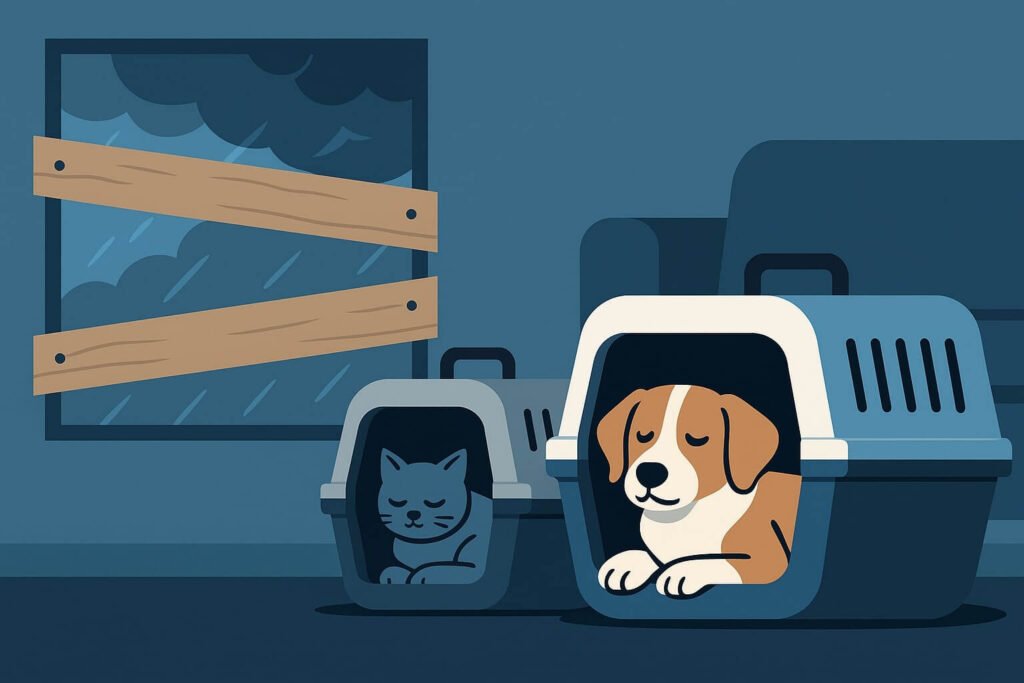When a hurricane rolls toward the coast, we rush to board windows, stock up on bottled water, fill the car with gas, but it’s easy to forget that the family dog or cat feels the shift too. Their ears perk at the low pressure, their routines break before the winds arrive, and the confusion of evacuation can leave them disoriented or even left behind. That’s why smart hurricane prep must include pets right from the start, not as an afterthought. In this guide, we’ll walk through how to prepare your pet before, during, and after the storm, with real-world tips pulled from both emergency responders and everyday pet owners who’ve been through it. Whether you’ve got a husky, a hamster or a pair of parrots, here’s how to keep every family member safe when the sirens start.
Why pet-focused hurricane prep matters
After Hurricane Katrina, thousands of pets were left behind in the chaos. Some were abandoned on rooftops, others escaped in panic, many were never reunited with their families. The heartbreak led to change: the U.S. passed the PETS Act, requiring shelters and emergency services to accommodate pets during disaster responses. Yet even now, many public shelters only accept animals with pre-registration or specific vaccination proof. That means your hurricane prep plan needs to start before the skies darken.
Think about it like this: pets have the same basic needs as we do during a storm, but fewer ways to meet them. They can’t speak for themselves, pack their food or navigate to a safe zone. They rely entirely on us. That includes the basics like ID tags, microchips, and vaccination records, but also emotional support, safe transport, and a consistent routine in an otherwise unstable situation.
Start by imagining a 7-day window where you and your pet are displaced. No power, no clean water, roads possibly blocked. What would they need? How would they react? That’s the starting point of a solid hurricane prep strategy.
What to pack, where to go, how to stay calm
The first part of hurricane prep for pets is the emergency go-bag. Experts agree that you should plan for at least 7 days away from home. For dogs and cats, that includes dry food in sealed bags, a gallon of water per pet per day, bowls, a leash or harness, copies of vaccination records, medications if needed, and a comfort item like a blanket or toy that smells like home. If you have a crate or carrier, label it clearly with your name and number, and practice loading your pet in and out before the storm.
Crate training might sound like an extra chore, but in an emergency shelter it can make a world of difference. Many animals panic when forced into a carrier for the first time, so letting your pet eat or nap in their crate a few times before hurricane season helps turn it into a safe space instead of a trap. It’s one of those “train now, thank yourself later” moments.
Plan your evacuation routes with pets in mind. Not all hotels accept animals, but apps like BringFido or PetFriendly can show you pet-safe lodging along major highways. Some counties also open designated pet shelters, but they tend to fill quickly and often require online pre-registration. Look that up now, not when everyone is trying to do it at once.
If you need to shelter in place, choose a windowless interior room, bring your pet inside early, and create a “pet bunker” with water bowls filled ahead of time, pee pads or litter boxes, and a few comfort items. Don’t light candles near anxious animals. Keep a battery-powered fan or calming music playing if possible, since wind gusts and pressure changes can make animals extra jumpy.
After the storm passes, resist the urge to let your pet roam. Floodwaters often contain sharp debris, chemicals, or downed wires. Leash walks only, until you’ve cleared the area. Some pets may behave differently after a traumatic event. A normally playful dog might become withdrawn or aggressive, or a cat might refuse to eat for a day or two. Be patient, give them time to adjust, and seek veterinary care if something seems off.
Final reminders before the next storm season
Hurricane prep isn’t just about checklists, it’s about building habits that keep you and your pets safe under pressure. Store your pet’s medical records and ID info in both physical and digital form, update microchip contact details, and rotate your emergency food stock every six months. If your pet is on prescription meds, ask your vet for an extra week’s supply to keep in your kit. Create a buddy system with neighbors in case you’re away when an evacuation is ordered, and leave a pet rescue alert sticker on your front door so emergency responders know who might be inside.
Most of all, treat hurricane prep like an act of love. Pets don’t understand weather alerts, but they feel our stress. The more calmly and confidently we act, the more secure they feel. So take a weekend, pack their bag, practice the routine, and know that you’re not just preparing for a storm, you’re protecting your family, paws and all.


